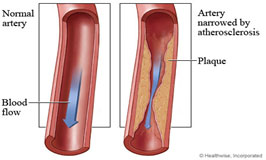What is a coronary artery disease?
Coronary artery disease (CAD) is the buildup of plaque in the arteries of the heart. Atherosclerosis is the hardening (and loss of elasticity) of the arteries. It is caused by the formation of multiple plaques within the arteries. This may also be called “calcifications”. The buildup of plaque narrows the arteries and restricts blood flow to the heart. When the blood flow becomes limited, it can cause a shortage of oxygen and glucose needed for cells to function (to keep tissue alive). This can result in the narrowing of coronary arteries over time. This can eventually lead to a heart attack. Acute ischemia is the result of a piece of plaque “rupturing” and traveling through the artery blocking blood flow. This results in a “sudden” heart attack and is the most common cause for “sudden death”. Coronary heart disease is the result of CAD, but health professionals use the terms interchangeably.

What causes coronary artery disease?
There are many risk factors that can contribute to CAD. They can include cholesterol levels (high LDL and low HDL), high blood pressure, diabetes, smoking, family history, being overweight, gender, age (>45 for men and post-menopausal for women), type A personality (high strung), lack of exercise, eating foods high in saturated fats and low in antioxidants, and frequent alcohol use.
How do I prevent coronary artery disease?
Some of the risk factors you cannot do anything about such as age, gender, and family history. Staying active and exercising, eating healthy, losing weight, stop smoking, and limiting alcohol consumption can decrease your chances of coronary artery disease developing or progressing. It is important to start preventative measures early in life because CAD begins in childhood. Researches have evidence that plaque formed in childhood stays with you for life.
What are the symptoms of coronary artery disease?
Most people do not experience symptoms until CAD is advanced. Common symptoms can be chest pain with pain radiating into back, jaw, and throat. Chest pain can occur while walking, doing activity/exercising, or just resting. Symptoms can also include shortness of breath, heart palpitations, breaking out in a sweat, and even feeling tired. Women and diabetics might have a “silent heart attack” which means they might have vague symptoms or no symptoms at all.
What happens next?
Your family doctor will talk to you about CAD. Your doctor might refer you to a cardiologist (heart doctor). They might do further tests to see how advanced your CAD is. Your doctor might start you on medications to help with cholesterol, thinning blood, or help with chest discomfort.
Who do I contact with any additional questions?
You can contact your family doctor who referred you for the screening.

